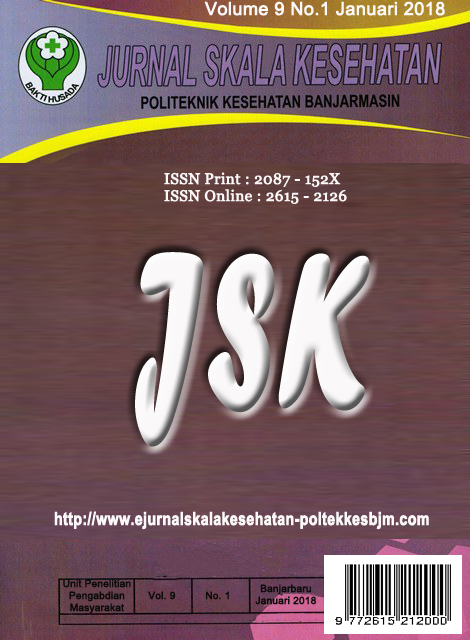Angka kuman udara ruang rawat inap anak dengan dan tanpa air conditioner (AC) di rumah sakit
Abstract
Air microorganisms can be found in outdoor or indoor air, ventilation is a very important place in the exchange of indoor air. Ventilation system is divided into two, namely natural ventilation and artificial ventilation in the form of Air Conditioner (AC). This study aims to determine the description of the number of germs in the inpatient wards of children using Air Conditioner (AC) and non (AC) at the Hospital in Martapura city area. This type of research is descriptive survey, the population is the inpatient room of children using Air Conditioner (AC) and non (AC). Sampling using purposive sampling technique, that is as much as 8 room. The examination method used is by TPC (Total Plate Count) method. The results showed that the number of airborne bacterial infections using the Air Conditioner (AC) was 406 CFU/m3. The total number of non-living inpatients (AC) is 443 CFU/m3. The standard maximum number of microorganisms (CFU / m3) of treatment room according to Kepmenkes No.1204/ Menkes/SK/X/2004 is 200-500 CFU / m3.References
R. Achmad, Kimia Lingkungan. Jakarta: Andi, 2004..
Amalia, R. D. Dwiyanti, and Haitami, “Daya Hambat Nacl Terhadap Pertumbuhan Staphylococcus aureus,” Med. Lab. Tecnol. J, vol. 2, n, p. pp. 42–45, 2016.
R. D. Dwiyanti and L. Lutpiatina, “Mutu Bakteriologis Saus Tomat Pentol Di Banjarbaru,” Med. Lab. Tecnol. J, vol. 2, no, pp. 1–5, 2016.
R. D. Dwiyanti, A. Muhlisin, and A. Muntaha, “MRSA dan VRSA Pada Paramedis RSUD Ratu Zalecha Martapura,” Med. Lab. Technol. J., vol. 1, no. 1, pp. 27–33, 2015.
A. S. Harti, Mikrobiologi Kesehatan. Yogyakarta: Andi, 2015.
H. Iswadi, Samingan, “Identifikasi Jenis Bakteri Udara Di Ruangan Bersistem HVAC (Heating Ventilation And Air Conditioning),” 2014
E. Lisyastuti, “Jumlah koloni mikroorganisme udara dalam Ruang dan hubungannya dengan kejadian sick Building syndrome (sbs) pada pekerja balai besar Teknologi kekuatan struktur (b2tks) bppt Di kawasan puspiptek serpong tahun 2010,” 2010.
L. Lutpiatina, “Pewarnaan Gram Buffy Coat Untuk Deteksi Awal Pasien Bakteremia,” Med. Lab. Technol. J., vol. 1, no. 1, pp. 38–46, 2015.
L. Lutpiatina, “Cemaran Staphylococcus aureus dan Pseudomonas aerogenosa Pada Stetoskop dirumah sakit.,” J. Teknol. Lab., vol. 6, no, 2017.
Moerdjoko, “Kaitan Sistem Ventilasi Bangunan Dengan Keberadaan Mikroorganisme Udara.,” Puslit J., vol. 32, n, pp. 89–94, 2004.
Mukono, Toksikologi Lingkungan. Surabaya: Airlangga Universitas Press, 2010.
A. . Sastrawijaya, Pencemaran Lingkungan. Jakarta: PT. Rineka Cipta, 2000.
R. T. Vindrahapsari, “Kondisi Fisik dan Jumlah Bakteri pada Ruangan AC dan Non AC di Sekolah Dasar.,” Universitas Muhammadiyah Semarang, 2016.
Publishing your paper with JURNAL SKALA KESEHATAN POLITEKNIK KESEHATAN BANJARMASIN (JSK) means that the author or authors retain the copyright in the paper. JSK granted an exclusive reuse license by the author(s), but the author(s) are able to put the paper onto a website, distribute it to colleagues, give it to students, use it in your thesis etc, even commercially. The author(s) can reuse the figures and tables and other information contained in their paper published by JSK in future papers or work without having to ask anyone for permission, provided that the figures, tables or other information that is included in the new paper or work properly references the published paper as the source of the figures, tables or other information, and the new paper or work is not direct at private monetary gain or commercial advantage. JSK journal provides immediate open access to its content on the principle that making research freely available to the public supports a greater global exchange of knowledge. This journal is licensed under a Creative Commons Attribution-ShareAlike 4.0 International License. This license lets others remix, transform, and build upon the material for any purpose, even commercially. JSK journal Open Access articles are distributed under this Creative Commons Attribution-ShareAlike 4.0 International License (CC BY-SA). Articles can be read and shared for All purposes under the following conditions:
BY: You must give appropriate credit, provide a link to the license, and indicate if changes were made. You may do so in any reasonable manner, but not in any way that suggests the licensor endorses you or your use.SA: If you remix, transform, or build upon the material, you must distribute your contributions under the same license as the original.






















